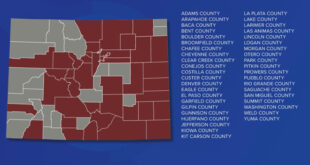Low-level helicopter flights are flying over a broad region of southwestern Colorado including the Gunnison Valley right now to image geology using airborne geophysical technology. Flying commenced in late June and will take up to two months to complete, weather and wildfire restrictions permitting. Flights will cover areas within Chaffee, Gunnison and Saguache counties.
The flights are based out of assorted regional airports, primarily in Salida and Gunnison. The flights could shift with little warning to other parts of the survey area as necessitated by adverse flying conditions.
The purpose of the survey is to provide images that expand the fundamental knowledge of geology underpinning a broad series of historic mining districts known as the Colorado Mineral Belt. The belt hosts multiple types of mineral commodities, including critical minerals that are vital to the nation’s security and economy.
The new geophysical data, along with geologic mapping by the Colorado Geological Survey (CGS) and USGS, will be combined to develop high-resolution three-dimensional representations of bedrock composition and structure to depths more than 3,280 feet (1 kilometer) below the surface.
The 3D models and maps are important for improving our understanding of critical mineral resource potential, water resources, groundwater pathways near legacy mining areas, parameters for infrastructure and land use planning and potential risks of naturally occurring radon. They also address scientific questions about Colorado’s two-billion-year-old geologic history and why multiple mineralizing events concentrated in one region over millions of years.
The helicopter will fly along pre-planned flight paths relatively low to the ground at about 300 feet (100 meters) above the surface. The ground clearance will be increased to 1,000 feet (300+ meters) over populated areas and will comply with Federal Aviation Administration (FAA) regulations. Flights will follow north-south lines spaced about 650 feet (200 meters) apart and east-west lines about 3,280 feet (1 km) apart. The USGS is contracting with NV5 Geospatial, Edcon-PRJ and Precision GeoSurveys to collect the data.
The survey will use a helicopter equipped with an elongated “stinger” mounted to the underside of the cabin extending forward of the helicopter. Instruments in the stinger and inside the cabin will measure variations in the Earth’s magnetic field and natural low-level radiation created by different rock types.
The scientific instruments on the helicopter are completely passive, with no emissions that pose a risk to humans, animals or plant life. No photography or video data will be collected. The data collected will be made freely available to the public once complete. The aircraft will be flown by experienced pilots who are specially trained and approved for low-level flying. The company works with the FAA to ensure flights are safe and in accordance with U.S. law. The surveys will be conducted during daylight hours only.
The survey fits into a broader effort by the USGS, the CGS and many other state geological surveys and other partners, including private companies, academics and State and Federal agencies, to modernize our understanding of the nation’s fundamental geologic framework and knowledge of mineral resources. This effort is known as the Earth Mapping Resources Initiative, or Earth MRI, and it includes airborne geophysical surveys like this one, geochemical reconnaissance surveys, topographic mapping using LiDAR technology, hyperspectral surveys and geologic mapping projects.
 The Crested Butte News Serving the Gunnison Valley since 1999
The Crested Butte News Serving the Gunnison Valley since 1999


